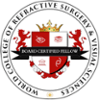Tonometry
What is it?
Tonometry is a method used to measure the pressure inside your eye (intraocular pressure). Optometrists and ophthalmologists perform a tonometry procedure as part of routine eye examinations to screen for eye diseases such as glaucoma.
How Does it Work?
A common tonometry method is the ‘air-puff’ method, which involves the use of an instrument to apply a small puff of air directly onto the eye. The tonometry instrument is then able to estimate the pressure inside the eye by measuring the change in the light reflected off the cornea as it is temporarily indented by the air puff.
It may be necessary for the clinician to perform the procedure several times on each eye to ensure accurate results.
Some optometrists may also (or instead) perform Goldmann tonometry or a similar ‘applanation’ method. Applanation involves anaesthetic drops containing a fluorescein dye being administered to numb the surface of the eye. You will then place your chin and forehead in supports on an instrument called a slit lamp.
A broad beam of blue light will be directed into your eye while the optometrist slowly moves the instrument towards you. Eventually, the tonometer probe will lightly touch the surface of your eye, allowing the optometrist to directly measure intraocular pressure by adjusting a tension dial on the tonometer.
What are the Benefits?
It is important to monitor intraocular pressure before Laser Eye Surgery is performed.
Our eyes produce a fluid for nourishment which eventually drains out of the eye. If the rate at which this fluid is produced and the rate at which it drains away is not balanced, it can affect the pressure in the eye. This can affect other structures in the eye, such as the optic nerve.
Furthermore, increased intraocular pressure is often associated with glaucoma. While glaucoma is a treatable condition, early diagnosis is often key to managing it effectively.
What Will I Feel?
What you will feel during a tonometry procedure will depend on the method used. In air-puff tonometry, only air makes contact with your eye. While this might make you flinch, it shouldn’t be uncomfortable or painful.
The use of anaesthetic eye drops for Goldmann tonometry should negate and discomfort from contact between your eye and the instrument.


